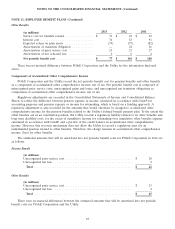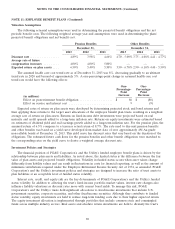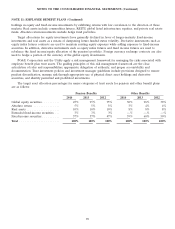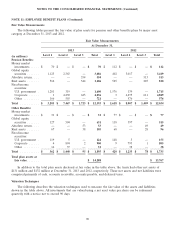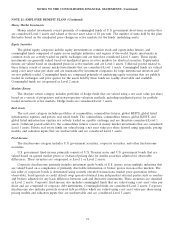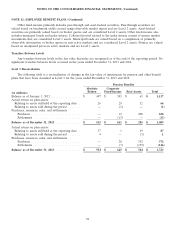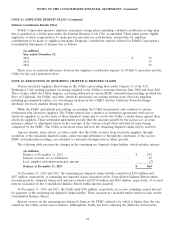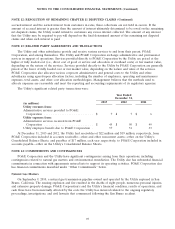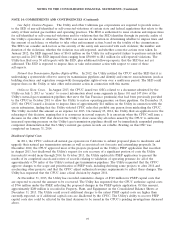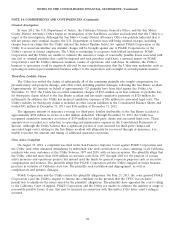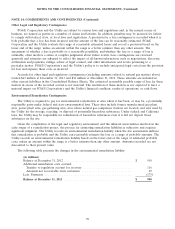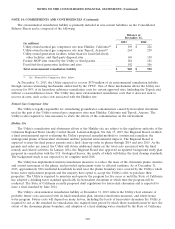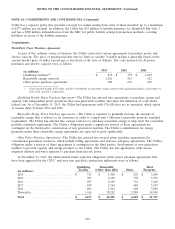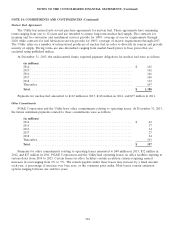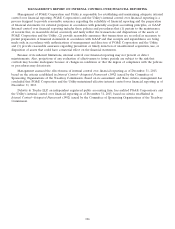PG&E 2013 Annual Report Download - page 103
Download and view the complete annual report
Please find page 103 of the 2013 PG&E annual report below. You can navigate through the pages in the report by either clicking on the pages listed below, or by using the keyword search tool below to find specific information within the annual report.NOTES TO THE CONSOLIDATED FINANCIAL STATEMENTS (Continued)
NOTE 14: COMMITMENTS AND CONTINGENCIES (Continued)
Gas Safety Citation Program. The Utility and other California gas corporations are required to provide notice
to the SED of any self-identified or self-corrected violations of certain state and federal regulations that relate to the
safety of their natural gas facilities and operating practices. The SED is authorized to issue citations and impose fines
for self-identified or self-corrected violations and for violations that the SED identifies through its periodic audits of
the Utility’s operations or otherwise. The SED can exercise its discretion in determining whether to impose fines and
the amount of such fines, or whether to take other enforcement action, based on the totality of the circumstances.
The SED can consider such factors as the severity of the safety risk associated with each violation; the number and
duration of the violations; whether the violation was self-reported, and whether corrective actions were taken. In
January 2012, the SED imposed fines of $16.8 million on the Utility for self-reported failure to perform certain leak
surveys and in 2013 the SED imposed fines ranging from $50,000 to $8.1 million for self-reported violations. The
Utility has filed over 50 self-reports with the SED, plus additional follow-up reports, that the SED has not yet
addressed. The SED is expected to impose fines or take enforcement action with respect to some of these
self-reports.
Natural Gas Transmission Pipeline Rights-of-Way. In 2012, the Utility notified the CPUC and the SED that it is
undertaking a system-wide effort to survey its transmission pipelines and identify and remove encroachments (such as
building structures and vegetation overgrowth) from pipeline rights-of-way over a multi-year period. The SED could
impose fines on the Utility or take other enforcement action in connection with this matter.
Orders to Show Cause. In August 2013, the CPUC issued two OSCs related to a document submitted by the
Utility on July 3, 2013 as ‘‘errata’’ to correct information about some segments in Lines 101 and 147 (two of the
Utility’s natural gas transmission pipelines that serve the San Francisco peninsula) that had been previously provided
to the CPUC in October 2011 to allow the Utility to restore operating pressure on these pipelines. On December 19,
2013, the CPUC issued a decision to impose fines of approximately $14 million on the Utility in connection with the
errata submission, finding that the Utility violated CPUC rules that prohibit any person from misleading the CPUC.
The Utility recorded this amount as an expense for 2013. On January 23, 2014, the Utility filed an application for the
rehearing of this decision, arguing that it is erroneous in several respects. It is uncertain when the CPUC will issue a
decision on the other OSC that directed the Utility to show cause why all orders issued by the CPUC to authorize
increased operating pressure on the Utility’s gas transmission pipelines should not be immediately suspended pending
competent demonstration that the Utility’s natural gas system records are reliable. Briefing on this OSC was
completed on January 31, 2014.
Disallowed Capital Costs
In 2011, the CPUC ordered all natural gas operators in California to submit proposed plans to modernize and
upgrade their natural gas transmission systems as well as associated cost forecasts and ratemaking proposals. In
December 2012, the CPUC approved most of the projects proposed in the Utility’s PSEP application that was filed
in August 2011, but disallowed the Utility’s request for rate recovery of a significant portion of costs the Utility
forecasted it would incur through 2014. In October 2013, the Utility updated its PSEP application to present the
results of its completed search and review of records relating to validation of operating pressure for all of the
approximately 6,750 miles of the Utility’s natural gas transmission pipelines. The Utility requested that the CPUC
approve changes to the scope and prioritization of PSEP work, including deferring some projects to after 2014 and
accelerating other projects, and that the CPUC adjust authorized revenue requirements to reflect these changes. The
Utility has requested that the CPUC issue a final decision by August 2014.
At December 31, 2013, the Utility has recorded cumulative charges of $549 million for PSEP capital costs that
are expected to exceed the amount to be recovered. The Utility has requested that the CPUC authorize capital costs
of $766 million under the PSEP, reflecting the proposed changes in the PSEP update application. Of this amount,
approximately $280 million is recorded in Property, Plant, and Equipment on the Consolidated Balance Sheets at
December 31, 2013. The Utility could record additional charges to the extent PSEP capital costs are higher than
currently expected, or if additional capital costs are disallowed by the CPUC. The Utility’s ability to recover PSEP
capital costs also could be affected by the final decisions to be issued in the CPUC’s pending investigations discussed
above.
97


